Competency-based occupational health and safety training - Comcare
Competency-based occupational health and safety training - Comcare
Competency-based occupational health and safety training - Comcare
You also want an ePaper? Increase the reach of your titles
YUMPU automatically turns print PDFs into web optimized ePapers that Google loves.
SRC Commission<br />
The Management<br />
of Occupational<br />
Health <strong>and</strong> Safety<br />
in Commonwealth<br />
Agencies<br />
competency-<strong>based</strong><br />
<strong>occupational</strong> <strong>health</strong> <strong>and</strong><br />
<strong>safety</strong> <strong>training</strong>
© Commonwealth of Australia 2000<br />
This work is copyright. Apart from any use as permitted<br />
under the Copyright Act 1968, no part may be reproduced<br />
by any process without prior permission from <strong>Comcare</strong>.<br />
ISBN — 1 876700 06 8 (hard copy)<br />
ISBN — 1 876700 35 1<br />
Publishing Notice<br />
This publication has been published with changes to the<br />
cover page, logo <strong>and</strong> contact details only. Content has<br />
not been altered.
Contents<br />
Guidance Material on <strong>Competency</strong>-Based Occupational Health & Safety Training.......... 4<br />
Foreword .......................................................................................................... 4<br />
1. Introduction .................................................................................................................... 5<br />
1.1 Title ............................................................................................................ 5<br />
1.2 Purpose ...................................................................................................... 5<br />
1.3 Definition ................................................................................................... 5<br />
2. What are OHS Competencies ....................................................................................... 6<br />
2.1 General ....................................................................................................... 6<br />
2.2 NOHSC Guidelines ................................................................................... 6<br />
2.3 National Industry Training Framework ..................................................... 6<br />
3. OHS Competencies within the OHS Framework ........................................................... 8<br />
3.1 Employers' Duty of Care ............................................................................ 8<br />
3.2 OHS Management Systems (OHSMS) ...................................................... 8<br />
3.3 Competence <strong>and</strong> OHS Outcomes .............................................................. 9<br />
4. Integrating OHS Competencies in the workplace......................................................... 11<br />
4.1 Assessment of <strong>Competency</strong> ..................................................................... 11<br />
4.2 Development of Training Programs......................................................... 11<br />
4.3 Contributions from other Agencies .......................................................... 11<br />
4.4 Published Material ................................................................................... 13<br />
4.5 Investigations <strong>and</strong> Reports ....................................................................... 15<br />
4.6 Training Delivery ..................................................................................... 15<br />
5. Monitoring <strong>and</strong> Review ................................................................................................ 17<br />
5.1 Stocktaking .............................................................................................. 17<br />
5.2 Review ..................................................................................................... 17<br />
Schedule 1 ....................................................................................................................... 18<br />
Table 1 ....................................................................................................................... 18<br />
Table 2 ....................................................................................................................... 3<br />
19<br />
Table 3 ....................................................................................................................... 20<br />
Establishing an OHS management system<br />
3
Guidance material on competency-<strong>based</strong><br />
<strong>occupational</strong> <strong>health</strong> <strong>and</strong> <strong>safety</strong> <strong>training</strong><br />
Foreword<br />
This guidance material is intended to build on the Safety, Rehabilitation <strong>and</strong> Compensation<br />
Commission's (SRCC) Occupational Health <strong>and</strong> Safety (OHS) Risk Management Model.<br />
The model reflects the Commission's view that the most efficient <strong>and</strong> effective way to<br />
create <strong>and</strong> maintain a <strong>health</strong>y <strong>and</strong> safe work environment is for Commonwealth agencies to<br />
integrate OHS risk management into their daily business operations.<br />
The OHS Risk Management Model underpins the basic OHS infrastructure prescribed in<br />
the Occupational Health <strong>and</strong> Safety (Commonwealth Employment) Act 1991 (the OHS<br />
(CE) Act). It is suitable for application in both large <strong>and</strong> small organisations, in all work<br />
environments <strong>and</strong> for the prevention of any type of work related injury <strong>and</strong>/or disease.<br />
The Model provides six general principles for the integration of OHS risk management into<br />
an organisation's daily business operations. These principles are:<br />
• Senior management leadership <strong>and</strong> commitment;<br />
• Active involvement of each individual in the workplace;<br />
• Effective communication through consultation;<br />
• Provision of appropriate information, education <strong>and</strong> <strong>training</strong>;<br />
• Hazard identification, risk assessment <strong>and</strong> risk control at workplace level; <strong>and</strong><br />
• Development <strong>and</strong> implementation of OHS management information systems.<br />
This material builds on SRCC advice already available on OHS Management Systems <strong>and</strong><br />
provides:<br />
• guidance on where OHS competency st<strong>and</strong>ards fit within both the OHS framework<br />
<strong>and</strong> the national industry <strong>training</strong> framework;<br />
• suggestions about integrating OHS competencies within the workplace; <strong>and</strong><br />
• directions towards resources which agencies can use to develop competency-<strong>based</strong><br />
OHS <strong>training</strong> programs aligned with their core business.<br />
The SRCC considers that competency-<strong>based</strong> OHS <strong>training</strong> can be delivered most<br />
effectively in the context of competency-<strong>based</strong> <strong>training</strong> for the core business functions of<br />
the agency. To the extent that it may be necessary to provide regulation <strong>and</strong> direction, this<br />
will be within the guidelines laid down in the Commission's Principles of Regulation,<br />
which focus on outcomes rather than prescription of process.<br />
4<br />
4<br />
Establishing an OHS management system
1 Introduction<br />
1.1 Title<br />
1.1.1 This document may be cited as the Safety, Rehabilitation <strong>and</strong> Compensation<br />
Commission Guidance Material on <strong>Competency</strong>-<strong>based</strong> Occupational Health <strong>and</strong><br />
Safety Training.<br />
1.2 Purpose<br />
1.2.1 To assist employers to meet their responsibilities under the OHS(CE) Act by<br />
providing guidance on resources available to support development <strong>and</strong><br />
implementation of competency-<strong>based</strong> OHS <strong>training</strong> programs by Commonwealth<br />
employers.<br />
1.3 Definition<br />
1.3.1 For the purposes of this material, "competency" refers to the skills <strong>and</strong> knowledge<br />
agreed by Australian industries to be needed for effective performance in the<br />
workplace.<br />
5<br />
Establishing an OHS management system<br />
5
2 What are OHS competencies<br />
2.1 General<br />
2.1.1 OHS competencies are the competencies required to implement an effective OHS<br />
management system consistent with OHS legislative requirements throughout<br />
Australia.<br />
2.2 NOHSC Guidelines<br />
2.2.1 In November 1998, the National Occupational Health <strong>and</strong> Safety Commission<br />
(NOHSC) published the second edition of its National Guidelines for Integrating<br />
Occupational Health <strong>and</strong> Safety Competencies into National Industry <strong>Competency</strong><br />
St<strong>and</strong>ards.<br />
The NOHSC Guidelines provide a range of generic OHS competencies which are<br />
described as minimum competencies for the implementation of effective OHS<br />
management in Australian workplaces. A summary of the generic competencies is at<br />
Schedule 1. The Guidelines encourage the incorporation of these competencies into<br />
industry competency st<strong>and</strong>ards. There are three different "units" of competence,<br />
relevant for different levels of responsibility in the workplace:<br />
i) Employees without management or supervisory responsibility;<br />
ii)<br />
iii)<br />
Employees with supervisory responsibilities;<br />
Employees with management responsibilities.<br />
These guidelines were developed in conjunction with NOHSC stakeholders <strong>and</strong> ANTA.<br />
2.3 National Industry Training Framework<br />
2.3.1 The Australian National Training Authority (ANTA)<br />
ANTA is an industry-<strong>based</strong> board, whose mission is:<br />
"To ensure that the skills of the Australian labour force are sufficient to support<br />
internationally competitive commerce <strong>and</strong> industry <strong>and</strong> to provide individuals with<br />
opportunities to optimise their potential."<br />
ANTA supports the development of competency st<strong>and</strong>ards, assessment guidelines<br />
<strong>and</strong> qualifications frameworks through Industry Training Advisory Bodies (ITABs).<br />
6<br />
6<br />
Establishing an OHS management system
2.3.2 Commonwealth Agencies <strong>and</strong> the National Industry Training Framework<br />
As indicated above, the national industry <strong>training</strong> framework is primarily directed<br />
towards ensuring internationally competitive Australian commerce <strong>and</strong> industry.<br />
While its primary focus is not on the public sector, <strong>training</strong> packages developed for<br />
specific industries within the framework may provide useful guidance on the<br />
integration of OHS competencies with competencies required for the work of the<br />
agency. For example, Business Services Training Australia <strong>and</strong> the Information<br />
Services <strong>and</strong> Telecommunications ITAB are organisations which may be able to<br />
assist with guidance.<br />
2.3.3 PSETA<br />
The National Public Services Training Package developed by Public Service<br />
Education <strong>and</strong> Training Australia (PSETA) include specific OHS competencies for<br />
the public sector. These are modelled on generic st<strong>and</strong>ards published by NOHSC <strong>and</strong><br />
described at Schedule 1.<br />
Further information on PSETA's work is in section 4 of this guidance material.<br />
2.3.4 OHS Competencies in the Workplace<br />
<strong>Competency</strong> st<strong>and</strong>ards endorsed by PSETA <strong>and</strong> ITABs vary in their treatment of<br />
OHS issues. Agencies will need to ensure that st<strong>and</strong>ards which are adopted take<br />
appropriate account of OHS implications of the work of the agency.<br />
7<br />
Establishing an OHS management system<br />
7
3 OHS competencies with the OHS framework<br />
3.1 Employers' Duty of Care<br />
3.1.1 Legislated Requirement<br />
Paragraph 16(2)(e) of the OHS (CE) Act requires employers:<br />
"to provide to the employees, in appropriate languages, the information, instruction,<br />
<strong>training</strong> <strong>and</strong> supervision necessary to enable them to perform their work in a manner<br />
that is safe <strong>and</strong> without risk to their <strong>health</strong>."<br />
This requirement is integral to the employer's general duty of care under section 16<br />
<strong>and</strong> is considered in the context of the Planned Investigation Program, which is<br />
discussed below.<br />
3.1.2 Other Employer Duties<br />
Hazard-<strong>based</strong> regulations <strong>and</strong> codes of practice issued under the OHS (CE) Act, as<br />
well as SRCC guidance material, include requirements for <strong>training</strong> of employees <strong>and</strong><br />
contractors.<br />
3.2 OHS Management Systems (OHSMS)<br />
3.2.1 The SRCC/<strong>Comcare</strong> Guide<br />
The Guide published by the SRCC <strong>and</strong> <strong>Comcare</strong> Establishing an OHS Management<br />
System provides agencies with practical help in establishing <strong>and</strong> maintaining an<br />
OHSMS <strong>and</strong> on how to integrate OHS management systems into every aspect of an<br />
agency's core business.<br />
The Guide is available on the OHS publications page on <strong>Comcare</strong>’s web site at<br />
(http://www.comcare.gov.au).<br />
3.2.2 Competencies within OHSMS<br />
An OHSMS represents a systematic management approach that can assist in meeting<br />
legal requirements <strong>and</strong> lead to sustained improvement in OHS performance.<br />
Effective implementation <strong>and</strong> maintenance of an OHSMS is dependent on the<br />
competency of an organisation's people.<br />
For an OHSMS to be effective, managers at all levels need to be knowledgeable<br />
about their legislative obligations <strong>and</strong> the risks <strong>and</strong> hazards specific to their<br />
organisation. Employees need to be competent to h<strong>and</strong>le their assigned task,<br />
particularly where there may be a significant risk or hazard present.<br />
8<br />
8<br />
Establishing an OHS management system
Suggested ways of developing OHS competency st<strong>and</strong>ards within an OHSMS<br />
include:<br />
- using existing industry competency st<strong>and</strong>ards;<br />
- examining job or position descriptions;<br />
- analysing work tasks;<br />
- analysing results of inspections <strong>and</strong> audits;<br />
- reviewing incident reports.<br />
3.2.3 OHSMS in the Workplace<br />
The SRC Commission <strong>and</strong> <strong>Comcare</strong> strongly support the adoption of a suitable<br />
OHSMS in each agency. However, agencies should be aware that one of the principal<br />
reasons why an OHSMS can fail to make the expected impact on workplace <strong>health</strong><br />
<strong>and</strong> <strong>safety</strong> is that it may become a "paper system": a complex set of procedures which<br />
are not translated into practical or sustained action.<br />
For this reason, agencies need to continue, after initial adoption of an OHSMS, to put<br />
effort into implementation, review <strong>and</strong> monitoring of its effectiveness.<br />
One way of helping to keep the OHSMS alive <strong>and</strong> practical is to integrate OHS<br />
competencies into the competencies required to be developed for the core business of<br />
the agency.<br />
3.3 Competence <strong>and</strong> OHS Outcomes<br />
3.3.1 The Effects of Employee Training<br />
It is clear that agencies will not achieve positive OHS outcomes unless there are<br />
programs in place which enable employees to carry out their work safely. Within<br />
these programs, which will include elements of a variety of risk management<br />
measures, it is difficult to identify objectively how employee <strong>training</strong> programs relate<br />
directly to changes in outcomes. Nevertheless, instruction in safe work practices<br />
should form an integral part of an agency's <strong>training</strong> for core business.<br />
Where appropriate, for example in an environment with exposure to identified<br />
hazards, this <strong>training</strong> may require assessment of competency before an employee<br />
takes up duty. Assessment in a competency-<strong>based</strong> <strong>training</strong> system is criterionreferenced.<br />
The aim of criterion-referenced assessment is to identify individuals'<br />
achievement of defined outcomes, rather than relating their performance to that of<br />
other learners.<br />
9<br />
Establishing an OHS management system<br />
9
<strong>Competency</strong>-<strong>based</strong> <strong>training</strong> is valuable in providing operational, technical <strong>and</strong> trade<br />
skills <strong>and</strong> has benefits including:<br />
- Learning <strong>and</strong> assessing on-the-job;<br />
- Relevant <strong>and</strong> specific skills;<br />
- specified st<strong>and</strong>ards;<br />
- Uniform outcomes;<br />
- Recognised <strong>training</strong>; <strong>and</strong><br />
- Workforce accountability <strong>and</strong> workplace management.<br />
All these benefits should be expected to have a positive impact on OHS outcomes,<br />
but it must be recognised that competency-<strong>based</strong> <strong>training</strong> also has certain limitations,<br />
for example in providing generic skills such as communication or attitudinal/<br />
behavioural change.<br />
In addition, competency-<strong>based</strong> <strong>training</strong> is restricted in considering understood <strong>and</strong><br />
experiential knowledge.<br />
3.3.2 The Effects of Manager Commitment & Training<br />
As indicated in the Foreword to this material, the first principle of the SRCC's Risk<br />
Management Model is "Senior management leadership <strong>and</strong> commitment". Manager<br />
commitment has long been recognised as a prerequisite to improving OHS outcomes<br />
<strong>and</strong> is a necessary first step in establishing an OHSMS. Commitment will be<br />
practically demonstrated by (among other things) allocation of an appropriate level of<br />
resources to OHS <strong>training</strong> programs.<br />
A report for NOHSC, "CEO <strong>and</strong> Supervisor Drivers", identified individual<br />
management <strong>training</strong> as a possible pathway for reinforcing the OHS accountability of<br />
supervisors. Training will assist managers in effectively attending to OHS issues <strong>and</strong><br />
systematically managing <strong>safety</strong>. Risk management, hazard awareness <strong>and</strong> risk<br />
perception are important components for supervisor <strong>training</strong>.<br />
It should be noted that management education <strong>and</strong> commitment needs to be<br />
continually renewed. For example, the Warden's Report into the Moura No 2 Mine<br />
disaster stated, "even if we had the 'improved' education in place it cannot be<br />
assumed that it will survive forever". Continued professional development <strong>and</strong><br />
improved professional status for OHS education would encourage the continual<br />
improvement of knowledge in managers.<br />
10<br />
10<br />
Establishing an OHS management system
4 Integrating OHS competencies in the workplace<br />
4.1 Assessment of <strong>Competency</strong><br />
4.1.1 A first step in the integration of OHS competencies in the workplace is the<br />
establishment of target st<strong>and</strong>ards to be achieved <strong>and</strong> comparison of existing st<strong>and</strong>ards<br />
with those targets.<br />
Initial assessment of existing st<strong>and</strong>ards of OHS competency within the agency can be<br />
achieved through a number of techniques, including readily-available sources:<br />
- Risk assessments;<br />
- Any Planned Investigation Program (PIP) reports provided by <strong>Comcare</strong>;<br />
- Accident <strong>and</strong> incident reports;<br />
- Internal agency OHS audits;<br />
- Purpose-designed surveys.<br />
4.2 Development of Training Programs<br />
4.2.1 The range <strong>and</strong> complexity of competency-<strong>based</strong> OHS <strong>training</strong> programs which an<br />
agency will need to develop will depend on a range of factors, including:<br />
- The size <strong>and</strong> risk profile of the agency;<br />
- The level of sophistication of the agency's OHSMS;<br />
- Commitments within agency OHS Agreements;<br />
- The existing level of attainment of OHS competencies by agency staff.<br />
Agencies will also need to consider how various styles <strong>and</strong> types of <strong>training</strong> are<br />
suited to the particular circumstances of their working environment. For example, are<br />
OHS competencies in the agency best attained through formal <strong>training</strong> sessions,<br />
through external courses or through on-the-job <strong>training</strong><br />
4.3 Contributions from other Agencies<br />
4.3.1 Learning by Example<br />
A number of agencies, particularly larger organisations with ready access to both<br />
<strong>training</strong> <strong>and</strong> OHS resources, have done extensive work on competency-<strong>based</strong> OHS<br />
<strong>training</strong> programs. In most cases the programs will be specific to the work of the<br />
agency: for example, an agency with large scale manual h<strong>and</strong>ling requirements will<br />
focus their programs on prevention of manual h<strong>and</strong>ling injuries.<br />
11<br />
Establishing an OHS management system<br />
11
Agencies may be willing to share their experience in development <strong>and</strong><br />
implementation of competency-<strong>based</strong> programs, <strong>and</strong> this experience may be<br />
adaptable to the needs of another agency.<br />
(It should be noted that information on agency programs may be available only on a<br />
commercial basis in some cases.)<br />
4.3.2 Networks<br />
It is advisable for agencies to take advantage of the experience of organisations<br />
outside the Commonwealth <strong>and</strong> outside the public sector, where possible. (Links to<br />
public sector organisations are available through the <strong>Comcare</strong> web site (http://<br />
www.comcare.gov.au/)). Both formal <strong>and</strong> informal consultative networks are useful<br />
in supporting agencies' <strong>training</strong> programs. The OHS professional bodies in each State<br />
<strong>and</strong> Territory, in particular, provide valuable forums for the exchange of information<br />
<strong>and</strong> advice. The following are relevant contact details:<br />
Organisation<br />
Safety Institute of Australia<br />
12<br />
Contact Details<br />
Admin Manager<br />
National Admin Manager<br />
PO Box 2078<br />
Gladstone Park VIC 3043<br />
Phone: (03) 8336 1995<br />
Fax: 03 8336 1995<br />
E-mail: natadmin@sia.org.au<br />
Australian <strong>and</strong> New Zeal<strong>and</strong> PO Box 304<br />
Society of Occupational Medicine Collins Street West<br />
Melbourne VIC 8007<br />
Ph: 1300 666 515<br />
Fax: (03) 9629 5944<br />
E-mail: anzsom@aol.com.au<br />
(www.anzsom.org.au/)<br />
Australian Institute of Occupational PO Box 1205<br />
Hygienists Organisation Tullamarine VIC 3043<br />
Ph: (03) 9335 2577<br />
Fax: (03) 9335 3454<br />
E-mail: aiohcc@ibm.net<br />
(www.aioh.org.au/contactM.htm)<br />
Ergonomics Society of Australia<br />
Creeda Business Centre<br />
281 Goyder Street<br />
Narrabundah ACT 2604<br />
Ph: (02) 6295 5959<br />
Fax: (02) 6295 5946<br />
E-mail: secretariate@ergonomics.org.au<br />
12<br />
Establishing an OHS management system
Other networks which agencies may find valuable include employer <strong>and</strong> employee<br />
organisations (links to individual employee organisations are accessible through the<br />
ACTU web site):<br />
Organisation<br />
Contact Details<br />
Australian Chamber of<br />
OHS Manager<br />
Commerce <strong>and</strong> Industry PO Box 18008<br />
Collins Street East<br />
Melbourne VIC 8003<br />
Ph: (03) 9668 9950<br />
Fax: (03) 9668 9958<br />
E-mail: melb@acci.org.au<br />
(www.acci.asn.au/contacts.htm)<br />
Australian Industry Group PO Box 289<br />
North Sydney NSW 2059<br />
Ph: (02) 9466 5566<br />
Fax: (02) 9466 5599<br />
Freecall: 1800 648 859<br />
(www.aigroup.asn.au/contacts.html)<br />
Australian Council of Trades Unions<br />
North Wing, Trades Hall<br />
Level 2<br />
393 Swanston Street<br />
Melbourne VIC 3000<br />
Ph: (03) 9663 5266<br />
Fax: (03) 9663 4051<br />
E-mail: mailbox@actu.asn.au<br />
4.4 Published Material<br />
4.4.1 NOHSC<br />
The NOHSC web site contains a national directory of OHS education <strong>and</strong> <strong>training</strong><br />
resources:<br />
(http://www.nohsc.gov.au/work/education/index.htm)<br />
The site contains education <strong>and</strong> <strong>training</strong> materials, for example the guide Small<br />
Business Management Training: Integrating Health <strong>and</strong> Safety Competencies:<br />
(http://www.nohsc.gov.au/work/education/sbetrain.exec.htm)<br />
The site also provides access to NOHSC publications:<br />
(http://www.nohsc.gov.au/publications/index.htm)<br />
13<br />
Establishing an OHS management system<br />
13
Agencies are particularly directed to the publications OHS <strong>Competency</strong> Based<br />
Training <strong>and</strong> Organising Health <strong>and</strong> Safety Training for your Workplace.<br />
4.4.2 ANTA<br />
The ANTA web site (http://www.anta.gov.au/) describes the national industry <strong>training</strong><br />
framework <strong>and</strong> provides links to ITAB sites.<br />
The site also contains links to ANTA publications:<br />
(http://www.anta.gov.au/PUBS/ALALLPUBS1.asp). These may be useful to agencies<br />
as a source of guidance on development of programs specific to the work of each<br />
agency within the broader context of the framework.<br />
4.4.3 PSETA<br />
The PSETA web site (http://www.pseta.com.au/) provides information on the<br />
National Public Services Training Package as well as contacts for members of all<br />
Commonwealth, State <strong>and</strong> Territory jurisdictions who are represented on PSETA.<br />
There is also detailed information at (http://www.pseta.com.au/) on public sector<br />
OHS competency st<strong>and</strong>ards at three levels:<br />
- Follow Defined OHS Policy <strong>and</strong> Procedures;<br />
- Implement <strong>and</strong> Monitor the Organisation's OHS Policies, Procedures <strong>and</strong><br />
Programs; <strong>and</strong><br />
- Establish, Maintain & Evaluate the Organisation's OHS System.<br />
These levels generally reflect the units of competence described in the NOHSC<br />
Guidelines.<br />
4.4.4 <strong>Comcare</strong><br />
The <strong>Comcare</strong> web site (http://www.comcare.gov.au/) provides access to a wide range<br />
of material specifically intended for agencies in the Commonwealth jurisdiction.<br />
The "Publications" area of the site enables agencies to obtain direct access to the bulk<br />
of OHS material published by <strong>Comcare</strong>: (http://www.comcare.gov.au/publications/<br />
index.html). The area includes access to publications on such issues as agencies'<br />
duties under the OHS (CE) Act, risks <strong>and</strong> hazards, certification <strong>and</strong> OHS<br />
management, as well as guidance on OHS <strong>training</strong> programs (including induction of<br />
new employees) at the agency level.<br />
4.4.5 State & Territory Jurisdictions<br />
Each State <strong>and</strong> Territory OHS jurisdiction maintains a web site with access to OHS<br />
material. Links to each of these sites are available from the <strong>Comcare</strong> site <strong>and</strong> each<br />
contains appropriate contact details.<br />
14<br />
14<br />
Establishing an OHS management system
4.5 Investigations <strong>and</strong> Reports<br />
4.5.1 Planned Investigation Program<br />
The Planned Investigation Program (PIP) is a structured process conducted by<br />
<strong>Comcare</strong> under the OHS (CE) Act which provides a detailed assessment of an<br />
agency's OHS management system against a range of criteria. A report is provided to<br />
the agency involved including, where appropriate, recommendations for<br />
improvement.<br />
PIP reports can be a valuable resource for agencies wishing to bring focus to a<br />
competency-<strong>based</strong> OHS <strong>training</strong> program. Agencies may wish to contact their local<br />
<strong>Comcare</strong> Regional Office or <strong>Comcare</strong>'s Operations <strong>and</strong> Investigations Group to<br />
discuss ways of taking full advantage of PIP findings <strong>and</strong> recommendations.<br />
The audit tool used by <strong>Comcare</strong> for the PIP (SafetyMAP) includes provision for<br />
review of the agency's OHS <strong>training</strong> program. Further details are available on the<br />
<strong>Comcare</strong> site at (http://www.comcare.gov.au/ohs/2/pip.html)<br />
4.5.2 Internal OHS Audits<br />
Agencies' internal audits of their OHS management systems may provide specifically<br />
for assessment of the status <strong>and</strong> effectiveness of OHS <strong>training</strong> programs. Audit<br />
reports may also provide a useful resource for bringing focus to competency-<strong>based</strong><br />
OHS <strong>training</strong> programs.<br />
4.5.3 Accident <strong>and</strong> Incident Investigations<br />
Investigation of an accident or incident (dangerous occurrence) in the workplace<br />
often reveals multiple causes of the occurrence. Key factors which may come into<br />
play include combined shortcomings in <strong>safety</strong> competency <strong>and</strong> competency in work<br />
skills.<br />
It is important that agencies review reports on accidents <strong>and</strong> incidents carefully to<br />
identify <strong>and</strong> correct contributing factors related to competency in <strong>safety</strong> or work<br />
skills.<br />
4.6 Training Delivery<br />
4.6.1 In-house or Outsourced<br />
While <strong>training</strong> of employees is a key element of employers' duty of care under the<br />
OHS (CE) Act, few agencies have the resources to deliver specialised <strong>training</strong> in<br />
areas such as OHS, particularly where unusual hazards or risks are concerned.<br />
Agencies may therefore need to consider the availability of suitable external<br />
resources for <strong>training</strong> program delivery.<br />
15<br />
Establishing an OHS management system<br />
15
4.6.2 Training Providers<br />
Short course <strong>training</strong> is often available through:<br />
- employer bodies <strong>and</strong> industry associations;<br />
- trade unions & their organisations eg. State/Territory Trades & Labour<br />
Councils;<br />
- private OHS service organisations; <strong>and</strong><br />
- <strong>training</strong> consultants.<br />
It is suggested that agencies take particular care, in contracting with providers of<br />
OHS <strong>training</strong>, that the <strong>training</strong> offered meets the special needs of the agency <strong>and</strong> can<br />
be suitably integrated with <strong>training</strong> for the agency's core business.<br />
Further information on the range of <strong>training</strong> available through a variety of sources,<br />
both for short courses <strong>and</strong> professional/technical education, can be accessed though<br />
the NOHSC web site at<br />
(http://www.nohsc.gov.au/OHSInformation/EducationAndTraining/default/html<br />
16<br />
16<br />
Establishing an OHS management system
5 Monitoring <strong>and</strong> review<br />
5.1 Stocktaking<br />
5.1.1 It is suggested that agencies examine the extent to which they are already making use<br />
of available resources relating to OHS competencies. This will provide a benchmark<br />
to assist them to assess whether the guidance material is useful to them <strong>and</strong> to<br />
identify improvements to OHS outcomes which they may achieve through<br />
implementation of future competency-<strong>based</strong> <strong>training</strong> programs.<br />
Feedback from agencies will assist <strong>Comcare</strong> to assess the usefulness of this guidance<br />
material to its intended audience <strong>and</strong> continuously improve it to meet agencies'<br />
requirements.<br />
5.2 Review<br />
5.2.1 It would be appropriate for <strong>Comcare</strong> to review progress periodically after publication<br />
of the guidance material, in the context of regular reporting on the Planned<br />
Investigation Program <strong>and</strong> the Prevention Program. This can be done by comparing<br />
results achieved on the relevant element of the SafetyMap audit tool.<br />
17<br />
Establishing an OHS management system<br />
17
Schedule 1<br />
Table 1--Summary of generic <strong>occupational</strong> <strong>health</strong> <strong>and</strong> <strong>safety</strong> competency A <strong>and</strong><br />
underpinning knowledge <strong>and</strong> skills<br />
Generic competency A<br />
Follow defined <strong>occupational</strong> <strong>health</strong> <strong>and</strong> <strong>safety</strong> policies <strong>and</strong> procedures relating to the work<br />
being undertaken in order to ensure own <strong>safety</strong> <strong>and</strong> that of others in the workplace.<br />
Units <strong>and</strong> Elements of <strong>Competency</strong><br />
Underpinning Knowledge <strong>and</strong> Skills<br />
Knowledge <strong>and</strong> Skills<br />
• Legal rights <strong>and</strong> responsibilities.<br />
Elements<br />
A.1 Follow workplace procedures for<br />
hazard identification <strong>and</strong> risk control.<br />
A.2 Contribute to participative<br />
arrangements for the management of<br />
<strong>occupational</strong> <strong>health</strong> <strong>and</strong> <strong>safety</strong>.<br />
• The way <strong>occupational</strong> <strong>health</strong> <strong>and</strong> <strong>safety</strong><br />
is managed in the workplace <strong>and</strong> legal<br />
requirements.<br />
• Workplace hazards.<br />
• Preferred ways to control risks.<br />
• Occupational <strong>health</strong> <strong>and</strong> <strong>safety</strong><br />
procedures.<br />
• Occupational <strong>health</strong> <strong>and</strong> <strong>safety</strong> symbols<br />
<strong>and</strong> signs.<br />
• Workplace designated <strong>occupational</strong><br />
<strong>health</strong> <strong>and</strong> <strong>safety</strong> personnel<br />
18<br />
18<br />
Establishing an OHS management system
Table 2--Summary of generic <strong>occupational</strong> <strong>health</strong> <strong>and</strong> <strong>safety</strong> competency B <strong>and</strong><br />
underpinning knowledge <strong>and</strong> skills<br />
Generic competency B<br />
Implement <strong>and</strong> monitor the organisation’s <strong>occupational</strong> <strong>health</strong> <strong>and</strong> <strong>safety</strong> policies,<br />
procedures <strong>and</strong> programs in the relevant work area to achieve <strong>and</strong> maintain <strong>occupational</strong><br />
<strong>health</strong> <strong>and</strong> <strong>safety</strong> st<strong>and</strong>ards.<br />
Units <strong>and</strong> Elements of <strong>Competency</strong><br />
Underpinning Knowledge <strong>and</strong> Skills<br />
Knowledge<br />
Elements<br />
B.1 Provide information to the work group<br />
about <strong>occupational</strong> <strong>health</strong> <strong>and</strong> <strong>safety</strong> <strong>and</strong><br />
the organisation's <strong>occupational</strong> <strong>health</strong> <strong>and</strong><br />
<strong>safety</strong> policies, procedures <strong>and</strong> programs.<br />
B.2 Implement <strong>and</strong> monitor participative<br />
arrangements for the management of<br />
<strong>occupational</strong> <strong>health</strong> <strong>and</strong> <strong>safety</strong>.<br />
B.3 Implement <strong>and</strong> monitor the<br />
organisation's procedures for identifying<br />
hazards <strong>and</strong> assessing risks.<br />
B.4 Implement <strong>and</strong> monitor the<br />
organisation's procedures for controlling<br />
risks.<br />
B.5 Implement the organisation's<br />
procedures for dealing with hazardous<br />
events.<br />
B.6 Implement <strong>and</strong> monitor the<br />
organisation's procedures for providing<br />
<strong>occupational</strong> <strong>health</strong> <strong>and</strong> <strong>safety</strong> <strong>training</strong>.<br />
B.7 Implement <strong>and</strong> monitor the<br />
organisation's procedures for maintaining<br />
<strong>occupational</strong> <strong>health</strong> <strong>and</strong> <strong>safety</strong> records.<br />
• Provisions of relevant <strong>occupational</strong><br />
<strong>health</strong> <strong>and</strong> <strong>safety</strong> legislation.<br />
• Principles <strong>and</strong> practice of effective<br />
<strong>occupational</strong> <strong>health</strong> <strong>and</strong> <strong>safety</strong><br />
management.<br />
• Workplace hazards, range <strong>and</strong> selection<br />
of control measures.<br />
• Organisational <strong>occupational</strong> <strong>health</strong> <strong>and</strong><br />
<strong>safety</strong> management systems <strong>and</strong><br />
policies <strong>and</strong> procedures needed for<br />
legislative compliance.<br />
• Impact of characteristics <strong>and</strong><br />
composition of the workforce on<br />
<strong>occupational</strong> <strong>health</strong> <strong>and</strong> <strong>safety</strong><br />
management.<br />
• Relevance of <strong>occupational</strong> <strong>health</strong> <strong>and</strong><br />
<strong>safety</strong> management to other<br />
organisational management policies,<br />
procedures <strong>and</strong> systems.<br />
Skills<br />
• Ability to analyse entire work<br />
environment <strong>and</strong> judge <strong>occupational</strong><br />
<strong>health</strong> <strong>and</strong> <strong>safety</strong> interventions.<br />
• Ability to analyse relevant workplace<br />
data.<br />
• Ability to assess resources needed for<br />
risk control.<br />
19<br />
Establishing an OHS management system<br />
19
Table 3--Summary of generic <strong>occupational</strong> <strong>health</strong> <strong>and</strong> <strong>safety</strong> competency C <strong>and</strong><br />
underpinning knowledge <strong>and</strong> skills<br />
Generic competency C<br />
Establish, maintain <strong>and</strong> evaluate the organisation’s <strong>occupational</strong> <strong>health</strong> <strong>and</strong> <strong>safety</strong> system<br />
in order to ensure that the workplace is, so far as is practicable, safe <strong>and</strong> without risks to<br />
the <strong>health</strong> of employees.<br />
Units <strong>and</strong> Elements of <strong>Competency</strong><br />
Underpinning Knowledge <strong>and</strong> Skills<br />
Knowledge<br />
Elements<br />
C.1 Establish <strong>and</strong> maintain the framework<br />
for the <strong>occupational</strong> <strong>health</strong> <strong>and</strong> <strong>safety</strong><br />
system in the area of managerial<br />
responsibility.<br />
C.2 Established <strong>and</strong> maintain participative<br />
arrangements for the management of<br />
<strong>occupational</strong> <strong>health</strong> <strong>and</strong> <strong>safety</strong>.<br />
C.3 Establish <strong>and</strong> maintain procedures for<br />
identifying hazards.<br />
C.4 Establish <strong>and</strong> maintain procedures for<br />
assessing risks.<br />
C.5 Establish <strong>and</strong> maintain procedures for<br />
controlling risks.<br />
C.6 Establish <strong>and</strong> maintain organisational<br />
procedures for dealing with hazardous<br />
events.<br />
C.7 Establish <strong>and</strong> maintain an<br />
<strong>occupational</strong> <strong>health</strong> <strong>and</strong> <strong>safety</strong> <strong>training</strong><br />
program.<br />
C.8 Establish <strong>and</strong> maintain a system for<br />
<strong>occupational</strong> <strong>health</strong> <strong>and</strong> <strong>safety</strong> records.<br />
C.9 Evaluate the organisation's<br />
<strong>occupational</strong> <strong>health</strong> <strong>and</strong> <strong>safety</strong> system <strong>and</strong><br />
related policies, procedures <strong>and</strong> programs.<br />
• Provisions of relevant <strong>occupational</strong><br />
<strong>health</strong> <strong>and</strong> <strong>safety</strong> legislation.<br />
• Principles <strong>and</strong> practice of effective<br />
<strong>occupational</strong> <strong>health</strong> <strong>and</strong> <strong>safety</strong><br />
management.<br />
• Management arrangements relating to<br />
regulatory compliance.<br />
• Enterprise hazards <strong>and</strong> risks, control<br />
measures <strong>and</strong> relevant expertise<br />
required.<br />
• Characteristics <strong>and</strong> composition of<br />
workforce <strong>and</strong> their impact on OHS<br />
management.<br />
• Relevance of enterprise management<br />
systems to OHS management.<br />
Skills<br />
• Ability to analyse working environment<br />
<strong>and</strong> design appropriate <strong>occupational</strong><br />
<strong>health</strong> <strong>and</strong> <strong>safety</strong> management systems.<br />
• Ability to analyse relevant data <strong>and</strong><br />
evaluate <strong>occupational</strong> <strong>health</strong> <strong>and</strong> <strong>safety</strong><br />
system effectiveness.<br />
• Ability to assess resources to establish<br />
<strong>and</strong> maintain <strong>occupational</strong> <strong>health</strong> <strong>and</strong><br />
<strong>safety</strong> management systems.<br />
20<br />
20<br />
Establishing an OHS management system
For further information contact<br />
<strong>Comcare</strong><br />
GPO Box 9905<br />
Canberra ACT 2601<br />
Telephone - 1300 366 979<br />
Email - ohs.help@comcare.gov.au<br />
Internet - www.comcare.gov.au<br />
OHS BK 22 (2000)


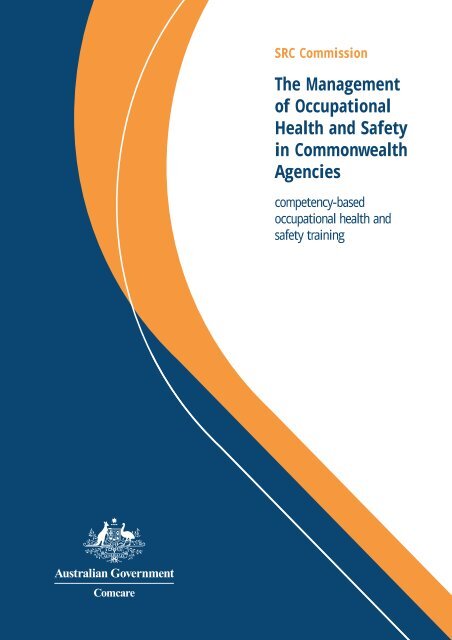

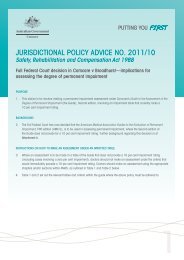
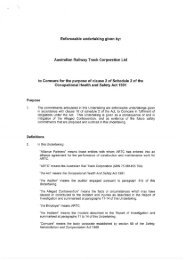

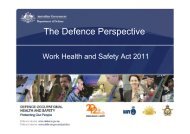
![Notification of demolition work [PDF,151KB] - Comcare](https://img.yumpu.com/49687354/1/184x260/notification-of-demolition-work-pdf151kb-comcare.jpg?quality=85)

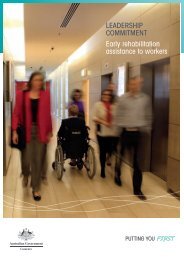


![Better practice guidance to decision making [PDF,672KB] - Comcare](https://img.yumpu.com/45283834/1/184x260/better-practice-guidance-to-decision-making-pdf672kb-comcare.jpg?quality=85)
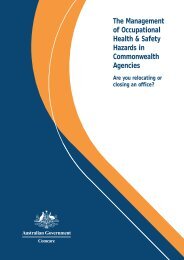

![Manual Handling Consultation paper [pdf] - Comcare](https://img.yumpu.com/42826938/1/184x260/manual-handling-consultation-paper-pdf-comcare.jpg?quality=85)
